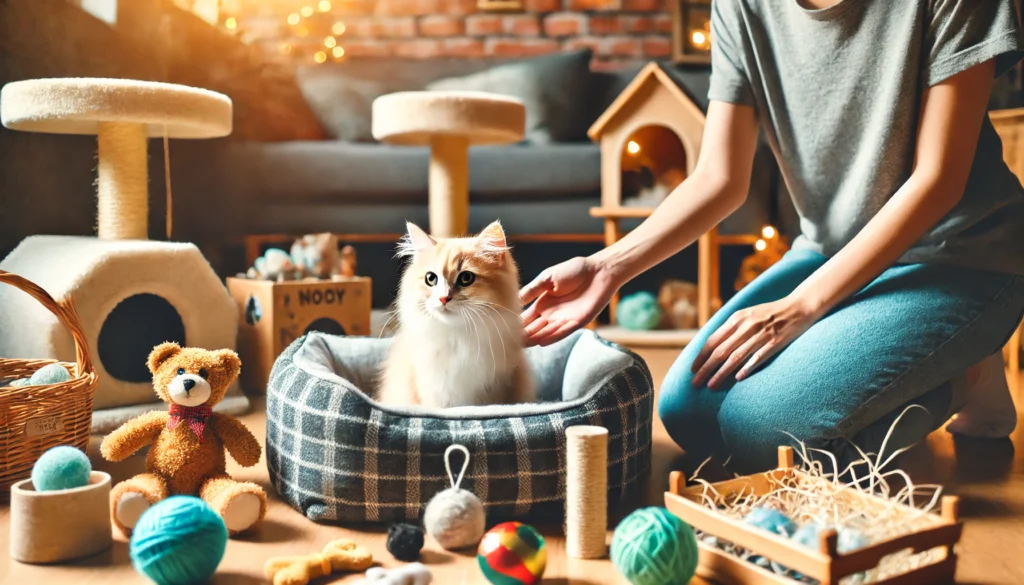Bringing a new cat home is an exciting time, full of expectations and joy. However, adapting a new feline to the home, especially in an environment where there are already other pets, requires care and planning. As a specialized veterinarian, I will share practical and valuable tips to ensure a smooth transition, minimizing stress for both the new cat and the residents already present.
Preparing the House for the New Cat
Before the arrival of the new family member, it is essential to prepare the environment. Set aside an exclusive space where he can feel safe and secure. This place should include a comfortable bed, litter box, scratching posts and toys. Keeping the new cat separate from other animals initially is crucial to avoid confrontations and allow for a gradual introduction.
Gradual Introduction: Essential Steps
First Olfactory Contact
Cats rely a lot on their sense of smell. Therefore, allow existing pets and the new cat to become familiar with each other's scents before meeting face-to-face. Exchanging personal items, such as blankets or toys, can help with this process. This way, both sides get used to the new aroma without the other's physical presence, reducing the initial impact.
Gradual Visual Introduction
After the olfactory phase, allow the cats to see each other from a distance, without direct contact. This can be done through an ajar door or a baby gate. Observe their behavior carefully. If there are signs of aggression, such as snorting or raised hair, prolong this phase before continuing.
First Supervised Meetings
When the cats seem calmer, begin supervised encounters in a neutral environment. Let them explore and get closer as they wish. Use treats and toys to associate the other cat's presence with something positive. It is important to remain calm and patient, not forcing interactions.

Managing Behavior: Signs and Solutions
Recognizing Stress
Cats can show stress in a variety of ways, such as hiding, excessive meowing, loss of appetite or even aggressive behavior. Identifying these signs early allows for quick intervention, avoiding more serious problems.
Positive Interventions
Using synthetic pheromones, such as Feliway, can help calm cats during the adjustment period. These products simulate cats' natural pheromones, promoting a sense of security. Additionally, maintaining a regular feeding and play routine helps create a predictable and safe environment.
Respecting Each Animal’s Time
Each cat is unique, with its own personality and rhythm. While some may adapt quickly, others may take weeks or even months. Respecting this time is essential for harmonious coexistence. Forcing interactions can result in long-term trauma and relationship difficulties.

Specific Tips for Environments with Other Pets
Introducing the Cat to Other Cats
When there are other cats in the house, the introduction process must be even more careful. Cats are territorial and may see the new addition as a threat. Following the gradual introduction steps is essential, as well as ensuring that each cat has its own space and resources, such as litter boxes and feeders.
Cat and Dog: A Different Encounter
If there is already a dog in the house, the introduction must be done with caution. Keep your dog on a leash during the first few meetings and allow him to smell the new cat from a distance. Reward calm behaviors and keep sessions short. Gradually increase the length of the meetings, always observing the behavior of both parties.
Maintaining Harmony in the Long Term
Environmental enrichment
Providing an enriched environment is crucial for cats' mental and physical health. Scratching posts, climbing shelves, interactive toys, and daily play sessions help keep cats stimulated and happy. A well-structured environment reduces stress and prevents destructive behaviors.
Continuous Monitoring
After the initial adaptation phase, continue monitoring interactions between the cats. Conflicts can arise even after weeks of coexistence. Be alert to any changes in behavior and intervene when necessary. Maintaining regular visits to the veterinarian ensures that all pets are healthy and well adjusted.
Rewards and Affection
Reinforce positive behaviors with treats and affection. Cats respond well to positive reinforcement and associating pleasant experiences with the presence of other pets helps to strengthen the bonds between them.
How to Introduce a New Cat into the House
Introducing a new cat into the home is a process that requires patience, attention and love. Each step, from initial preparation to long-term coexistence, is essential to ensure that the new cat and existing pets adjust healthily and harmoniously. With the strategies and tips presented, adaptation can be a success, providing a happy and balanced environment for everyone.
FAQs
How to avoid fights between cats during adaptation?
Use gradual introduction techniques, such as exchanging scents and supervised meetings. Reward positive behaviors and intervene in stressful situations, separating cats if necessary.
What is the average adaptation time for a new cat in the house?
Adaptation time can vary from weeks to months, depending on the cat's personality and the environment. Respecting the rhythm of each animal is essential.
Can I use synthetic pheromones during adaptation?
Yes, products like Feliway can help reduce stress and promote a calmer environment, making it easier for cats to adapt.
How long should I keep the new cat isolated?
Keep the new cat in a separate space for at least a week, allowing it to get used to the new environment before direct interactions with other pets.
How do you know if cats are adapting well?
Signs of positive adaptation include calm interactions, absence of aggressive behaviors, and willingness to share spaces. Continue monitoring and reinforcing positive behaviors.
What to do if cats don't adapt?
If cats do not adapt, consider consulting a veterinarian or animal behaviorist. They can offer additional, personalized strategies to improve coexistence.
Conclusion
Introducing a new cat into the home is a process that requires planning and patience, but with the right tips and strategies, it is possible to ensure a smooth and harmonious adaptation. The use of synthetic pheromones, environmental enrichment and positive reinforcement are valuable tools in this process. Continuously monitoring the cats' behavior and respecting each one's rhythm are essential steps to success. With dedication and care, your new cat and other pets will be able to live in harmony, creating a happy and balanced environment for everyone.
